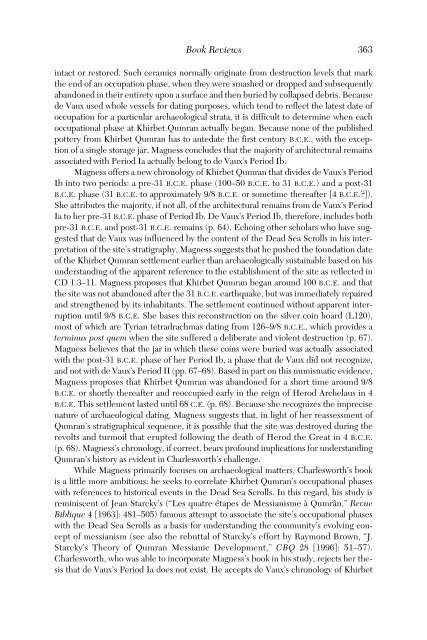Journal of Biblical Literature - Society of Biblical Literature
Journal of Biblical Literature - Society of Biblical Literature
Journal of Biblical Literature - Society of Biblical Literature
You also want an ePaper? Increase the reach of your titles
YUMPU automatically turns print PDFs into web optimized ePapers that Google loves.
Book Reviews<br />
intact or restored. Such ceramics normally originate from destruction levels that mark<br />
the end <strong>of</strong> an occupation phase, when they were smashed or dropped and subsequently<br />
abandoned in their entirety upon a surface and then buried by collapsed debris. Because<br />
de Vaux used whole vessels for dating purposes, which tend to reflect the latest date <strong>of</strong><br />
occupation for a particular archaeological strata, it is difficult to determine when each<br />
occupational phase at Khirbet Qumran actually began. Because none <strong>of</strong> the published<br />
pottery from Khirbet Qumran has to antedate the first century B.C.E., with the exception<br />
<strong>of</strong> a single storage jar, Magness concludes that the majority <strong>of</strong> architectural remains<br />
associated with Period Ia actually belong to de Vaux’s Period Ib.<br />
Magness <strong>of</strong>fers a new chronology <strong>of</strong> Khirbet Qumran that divides de Vaux’s Period<br />
Ib into two periods: a pre-31 B.C.E. phase (100–50 B.C.E. to 31 B.C.E.) and a post-31<br />
B.C.E. phase (31 B.C.E. to approximately 9/8 B.C.E. or sometime thereafter [4 B.C.E.?]).<br />
She attributes the majority, if not all, <strong>of</strong> the architectural remains from de Vaux’s Period<br />
Ia to her pre-31 B.C.E. phase <strong>of</strong> Period Ib. De Vaux’s Period Ib, therefore, includes both<br />
pre-31 B.C.E. and post-31 B.C.E. remains (p. 64). Echoing other scholars who have suggested<br />
that de Vaux was influenced by the content <strong>of</strong> the Dead Sea Scrolls in his interpretation<br />
<strong>of</strong> the site’s stratigraphy, Magness suggests that he pushed the foundation date<br />
<strong>of</strong> the Khirbet Qumran settlement earlier than archaeologically sustainable based on his<br />
understanding <strong>of</strong> the apparent reference to the establishment <strong>of</strong> the site as reflected in<br />
CD 1.3–11. Magness proposes that Khirbet Qumran began around 100 B.C.E. and that<br />
the site was not abandoned after the 31 B.C.E. earthquake, but was immediately repaired<br />
and strengthened by its inhabitants. The settlement continued without apparent interruption<br />
until 9/8 B.C.E. She bases this reconstruction on the silver coin hoard (L120),<br />
most <strong>of</strong> which are Tyrian tetradrachmas dating from 126–9/8 B.C.E., which provides a<br />
terminus post quem when the site suffered a deliberate and violent destruction (p. 67).<br />
Magness believes that the jar in which these coins were buried was actually associated<br />
with the post-31 B.C.E. phase <strong>of</strong> her Period Ib, a phase that de Vaux did not recognize,<br />
and not with de Vaux’s Period II (pp. 67–68). Based in part on this numismatic evidence,<br />
Magness proposes that Khirbet Qumran was abandoned for a short time around 9/8<br />
B.C.E. or shortly thereafter and reoccupied early in the reign <strong>of</strong> Herod Archelaus in 4<br />
B.C.E. This settlement lasted until 68 C.E. (p. 68). Because she recognizes the imprecise<br />
nature <strong>of</strong> archaeological dating, Magness suggests that, in light <strong>of</strong> her reassessment <strong>of</strong><br />
Qumran’s stratigraphical sequence, it is possible that the site was destroyed during the<br />
revolts and turmoil that erupted following the death <strong>of</strong> Herod the Great in 4 B.C.E.<br />
(p. 68). Magness’s chronology, if correct, bears pr<strong>of</strong>ound implications for understanding<br />
Qumran’s history as evident in Charlesworth’s challenge.<br />
While Magness primarily focuses on archaeological matters, Charlesworth’s book<br />
is a little more ambitious: he seeks to correlate Khirbet Qumran’s occupational phases<br />
with references to historical events in the Dead Sea Scrolls. In this regard, his study is<br />
reminiscent <strong>of</strong> Jean Starcky’s (“Les quatre étapes de Messianisme à Qumrân,” Revue<br />
Biblique 4 [1963]: 481–505) famous attempt to associate the site’s occupational phases<br />
with the Dead Sea Scrolls as a basis for understanding the community’s evolving concept<br />
<strong>of</strong> messianism (see also the rebuttal <strong>of</strong> Starcky’s effort by Raymond Brown, “J.<br />
Starcky’s Theory <strong>of</strong> Qumran Messianic Development,” CBQ 28 [1996]: 51–57).<br />
Charlesworth, who was able to incorporate Magness’s book in his study, rejects her thesis<br />
that de Vaux’s Period Ia does not exist. He accepts de Vaux’s chronology <strong>of</strong> Khirbet<br />
363

















